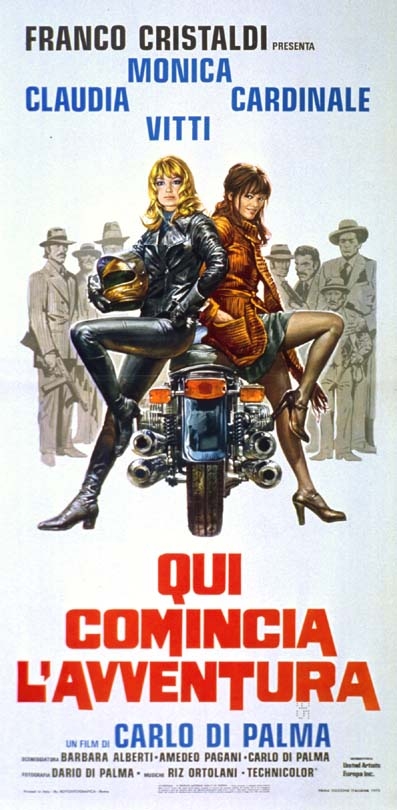★★★½
“Girls on a Motorcycle”
“What if we free everyone? Everyone who wants to come with us, not just children. We could make a gang that even Butch would be proud of. Stop by all the laundrettes, tell them all to come with us. And if they don’t want to come, it’s their loss.”
 Claudia (Cardinale) has a humdrum life working in a laundrette, with a sleazy husband and no hope of anything more exciting in her future. Into the laundrette storms the titular woman, Miele (Vitti), whose devil-may-care attitude enthralls Claudia, and gives her the courage to throw away her staid existence and follow the blonde on the road. Miele is initially resistant to the idea of a travelling companion, but rides to the rescue, driving her bike through the railway station where Claudia is being harassed. Miele must make a mysterious appointment in Northern Italy with her lover, but that’s okay, as Claudia has a cousin, on the way, in Naples. However, as the two make their way, it gradually becomes clear that Miele could give Baron Munchausen a run for his money, when it comes to spinning tall tales, and both her mouth and impetuous actions, are as likely to get the pair into trouble as out if it.
Claudia (Cardinale) has a humdrum life working in a laundrette, with a sleazy husband and no hope of anything more exciting in her future. Into the laundrette storms the titular woman, Miele (Vitti), whose devil-may-care attitude enthralls Claudia, and gives her the courage to throw away her staid existence and follow the blonde on the road. Miele is initially resistant to the idea of a travelling companion, but rides to the rescue, driving her bike through the railway station where Claudia is being harassed. Miele must make a mysterious appointment in Northern Italy with her lover, but that’s okay, as Claudia has a cousin, on the way, in Naples. However, as the two make their way, it gradually becomes clear that Miele could give Baron Munchausen a run for his money, when it comes to spinning tall tales, and both her mouth and impetuous actions, are as likely to get the pair into trouble as out if it.
It plays kinda like a pre-make (since it came out in 1975) of Thelma and Louise, directed by Stephen Chow, because it has the same mo lei tau (or “makes no sense”) approach. For instance, at one point, while Miele is re-enacting one of her alleged escapades. the bike careers off the road, with Miele left dangling from a tree. Several minutes later, after Claudia helps her down, in the background, you see the motor-cycle, still going, driving itself into the sea. Or later on, after they mistake a policeman for a criminal, they’re chased out the back of a train, and the film switches into b&w slapstick mode, with deliberately bad rear-projection, etc. No-one bats an eyelid at any of this. While the plot is flimsy, to say the least, it relies heavily on the charm of its leading ladies, and that aspect is a roaring success, right from the moment Vitti strides into the laundrette. Co-writers Barbara Alberti & Amedeo Pagani, who penned the script along with Di Palma, had just come off the similarly fetishistic The Night Porter, and Di Palma shoots proceedings with the eye of someone who was a cinematographer first (he was a frequent DP for Woody Allen in the eighties and nineties).
It’s a generally frothy confection, light in aim and intent, though has occasionally surprising moments of poignancy, and the reason behind Miele’s fantasies is impeccable. There is also a surprisingly impressive brawl (below), after the pair clean out a casino, in which Cardinale kicks ass thanks to some rather good staging. Considering Italy in the seventies was hardly a bastion of feminism, this is particularly impressive, and providing you aren’t looking for anything particularly meaningful – or even logical – has survived the forty years which have passed, much better than many of its era.
Dir: Carlo Di Palma
Star: Monica Vitti, Claudia Cardinale
a.k.a. Qui Comincia l’Avventura [“Here Begins the Adventure”]




